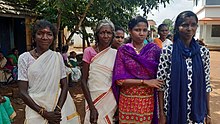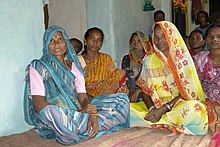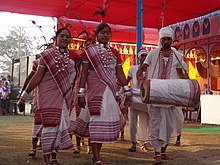
Back آديفاسي Arabic আদিবাসী Assamese आदिवासी Bihari আদিবাসী (ভারত) Bengali/Bangla Adivasi Catalan Adivasi German Αντιβάσι Greek Adivasioj Esperanto Adivasi Spanish Ādivāsī Estonian
This article needs additional citations for verification. (June 2024) |
The Adivasi are heterogeneous tribal groups across the Indian subcontinent.[1][2][3][4] The term is a self-designation adopted by those groups to assert indigeneity through socio-cultural identity.[5] They are officially recognized as "Scheduled Tribes" in India and as "Ethnic Minorities" in Bangladesh.[6][7] They comprise 8.6% of India's population and 1.1% of Bangladesh's;[8] or 104.2 million in India, according to the 2011 census, and 2 million in Bangladesh according to the 2010 estimate.[9][10][11][12]



Though claimed to be among the original inhabitants of India subcontinent, many present-day Adivasi communities formed after the decline of the Indus Valley civilisation, harboring various degrees of ancestry from ancient hunter-gatherers, Indus Valley civilisation, Indo-Aryan, Austroasiatic and Tibeto-Burman language speakers.[13][14][15]
Adivasi studies is a new scholarly field, drawing upon archaeology, anthropology, agrarian history, environmental history, subaltern studies, indigenous studies, aboriginal studies, and developmental economics. It adds debates that are specific to the Indian context.[16]
- ^ Engin F Isin (2015). Citizenship After Orientalism: An Unfinished Project. Taylor & Francis. p. 213. ISBN 978-1-317-68137-3. Archived from the original on 23 March 2023. Retrieved 23 March 2023.
Widely addressed as tribals, Adivasis are heterogeneous groups spread all over the nation having different languages and group identities.
- ^ Isin, Engin (2016). Citizenship after Orientalism: Transforming Political Theory. Palgrave Studies in Citizenship Transitions. Palgrave Macmillan UK. p. 202. ISBN 978-1-137-47950-1. Archived from the original on 23 March 2023. Retrieved 12 April 2023.
'Adivasi' literally means 'original inhabitant', and it refers to heterogeneous adivasis tribal groups living all over the subcontinent.
- ^ Cite error: The named reference
EB_Adivasiwas invoked but never defined (see the help page). - ^ Cite error: The named reference
booksandideaswas invoked but never defined (see the help page). - ^ Alles, Gregory D. (1 June 2017), "Are Adivasis Indigenous?", Handbook of Indigenous Religion(s), Brill, pp. 247–262, doi:10.1163/9789004346710_016, ISBN 978-90-04-34671-0, retrieved 26 January 2025,
In any case, the term adivasi is a relatively recent one, at most only a century old. Despite its recent origin, however, it is now widely used as a self-designation by many of the people whom the Government of India classes as Scheduled Tribes.
- ^ Cite error: The named reference
barnes1995was invoked but never defined (see the help page). - ^ Cite error: The named reference
Forwardpresswas invoked but never defined (see the help page). - ^ "Bangladesh – The World Factbook". Cia.gov. Archived from the original on 30 July 2021. Retrieved 10 July 2021.
- ^ "2011 Census Primary Census Abstract" (PDF). Censusindia.gov.in. Archived (PDF) from the original on 5 August 2020. Retrieved 11 June 2015.
- ^ "SCs, STs form 25% of population, says Census 2011 data – Indian Express". archive.indianexpress.com. Archived from the original on 16 July 2017. Retrieved 25 April 2015.
- ^ "CPI(M) demands reservation for SCs, STs in private sector". DNA India. 16 April 2015. Archived from the original on 14 July 2019. Retrieved 14 July 2019.
- ^ "Bangladesh | World Directory of Minorities & Indigenous Peoples". Minority Rights Group. 19 June 2015. Archived from the original on 10 July 2021. Retrieved 10 July 2021.
- ^ Reich et al. 2009.
- ^ Basu et al. 2016.
- ^ Narasimhan, Patterson & et al. 2019.
- ^ Dasgupta, Sangeeta (2018). "Adivasi studies: From a historian's perspective". History Compass. 16 (10). doi:10.1111/hic3.12486. Retrieved 7 June 2024.